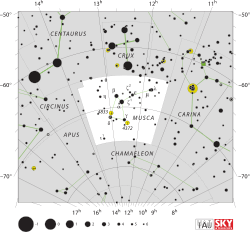Beta Muscae

| |
| Observation data Epoch J2000.0 Equinox J2000.0 (ICRS) | |
|---|---|
| Constellation | Musca |
| Right ascension | 12h 46m 16.80410s[1] |
| Declination | –68° 06′ 29.2164″[1] |
| Apparent magnitude (V) | 3.05 (3.51 + 4.01)[2] |
| Characteristics | |
| Spectral type | B2 V + B3 V[2] |
| U−B color index | –0.766[3] |
| B−V color index | –0.198[3] |
| Astrometry | |
| Radial velocity (Rv) | +42[4] km/s |
| Proper motion (μ) | RA: –41.97[1] mas/yr Dec.: –8.89[1] mas/yr |
| Parallax (π) | 9.55 ± 0.41[1] mas |
| Distance | 340 ± 10 ly (105 ± 4 pc) |
| Orbit[5] | |
| Period (P) | 194.28 yr |
| Semi-major axis (a) | 0.969" |
| Eccentricity (e) | 0.598 |
| Inclination (i) | 37.1° |
| Longitude of the node (Ω) | 349.4° |
| Periastron epoch (T) | 1857.50 |
| Argument of periastron (ω) (secondary) | 209.0° |
| Details | |
| β Mus A | |
| Mass | 7.35[6] M☉ |
| Age | 15.1 ± 1.2[7] Myr |
| β Mus B | |
| Mass | 6.40[6] M☉ |
| Other designations | |
Beta Muscae (β Muscae, β Mus) is a binary star in the southern circumpolar constellation of Musca. With a combined apparent visual magnitude of 3.07,[2] it is the second brightest star (or star system) in the constellation. Judging by the parallax results, it is located at a distance of roughly 330–350 light-years (100–110 parsecs) from the Earth.[1]
This is a binary star system with a period of about 194 years at an orbital eccentricity of 0.6.[5] As of 2007, the two stars had an angular separation of 1.206 arcseconds at a position angle of 35°.[6] The components are main sequence stars of similar size and appearance. The primary component, β Muscae A, has an apparent magnitude of 3.51, a stellar classification of B2 V,[2] and about 7.35 times the Sun's mass.[6] The secondary component, β Muscae B, has an apparent magnitude of 4.01, a stellar classification of B3 V,[2] and is about 6.40 times the mass of the Sun.[6]
This is a confirmed member of the Scorpius-Centaurus Association,[2][6] which is a group of stars with similar ages, locations, and trajectories through space, implying that they formed together in the same molecular cloud. Beta Muscae is considered a runaway star system as it has a high peculiar velocity of 43.9 km s−1 relative to the normal galactic rotation. Runaway stars can be produced through several means, such as through an encounter with another binary star system. Binary systems form a relatively small fraction of the total population of runaway stars.[9]
References
- 1 2 3 4 5 6 van Leeuwen, F. (November 2007), "Validation of the new Hipparcos reduction", Astronomy and Astrophysics, 474 (2): 653–664, arXiv:0708.1752
 , Bibcode:2007A&A...474..653V, doi:10.1051/0004-6361:20078357
, Bibcode:2007A&A...474..653V, doi:10.1051/0004-6361:20078357 - 1 2 3 4 5 6 Eggleton, P. P.; Tokovinin, A. A. (September 2008), "A catalogue of multiplicity among bright stellar systems", Monthly Notices of the Royal Astronomical Society, 389 (2): 869–879, arXiv:0806.2878
 , Bibcode:2008MNRAS.389..869E, doi:10.1111/j.1365-2966.2008.13596.x
, Bibcode:2008MNRAS.389..869E, doi:10.1111/j.1365-2966.2008.13596.x - 1 2 Gutierrez-Moreno, Adelina; Moreno, Hugo (June 1968), "A Photometric Investigation of the Scorpio-Centaurus Association", Astrophysical Journal Supplement, 15: 459, Bibcode:1968ApJS...15..459G, doi:10.1086/190168
- ↑ Wilson, Ralph Elmer (1953). General Catalogue of Stellar Radial Velocities. Washington: Carnegie Institution of Washington. Bibcode:1953GCRV..C......0W.
- 1 2 "Sixth Catalog of Orbits of Visual Binary Stars", U.S. Naval Observatory, retrieved 2008-06-22
- 1 2 3 4 5 6 Kouwenhoven, M. B. N.; Brown, A. G. A.; Portegies Zwart, S. F.; Kaper, L. (October 2007), "The primordial binary population. II. Recovering the binary population for intermediate mass stars in Scorpius OB2", Astronomy and Astrophysics, 474 (1): 77–104, arXiv:0707.2746
 , Bibcode:2007A&A...474...77K, doi:10.1051/0004-6361:20077719
, Bibcode:2007A&A...474...77K, doi:10.1051/0004-6361:20077719 - ↑ Tetzlaff, N.; Neuhäuser, R.; Hohle, M. M. (January 2011), "A catalogue of young runaway Hipparcos stars within 3 kpc from the Sun", Monthly Notices of the Royal Astronomical Society, 410 (1): 190–200, arXiv:1007.4883
 , Bibcode:2011MNRAS.410..190T, doi:10.1111/j.1365-2966.2010.17434.x
, Bibcode:2011MNRAS.410..190T, doi:10.1111/j.1365-2966.2010.17434.x - ↑ "CCDM J12463-6806AB -- Double or multiple star", SIMBAD, Centre de Données astronomiques de Strasbourg, retrieved 2012-01-20
- ↑ Hoogerwerf, R.; de Bruijne, J. H. J.; de Zeeuw, P. T. (January 2001), "On the origin of the O and B-type stars with high velocities. II. Runaway stars and pulsars ejected from the nearby young stellar groups", Astronomy and Astrophysics, 365: 49–77, arXiv:astro-ph/0010057
 , Bibcode:2001A&A...365...49H, doi:10.1051/0004-6361:20000014
, Bibcode:2001A&A...365...49H, doi:10.1051/0004-6361:20000014
External links
- Kaler, James B., "Beta Muscae", Stars, University of Illinois, retrieved 2012-01-20